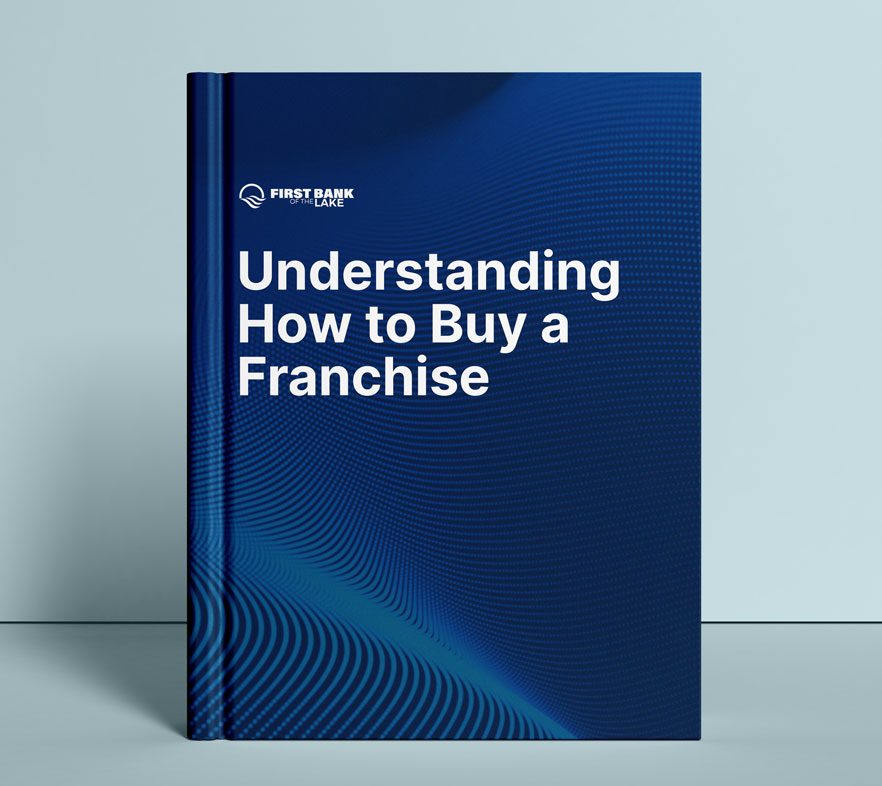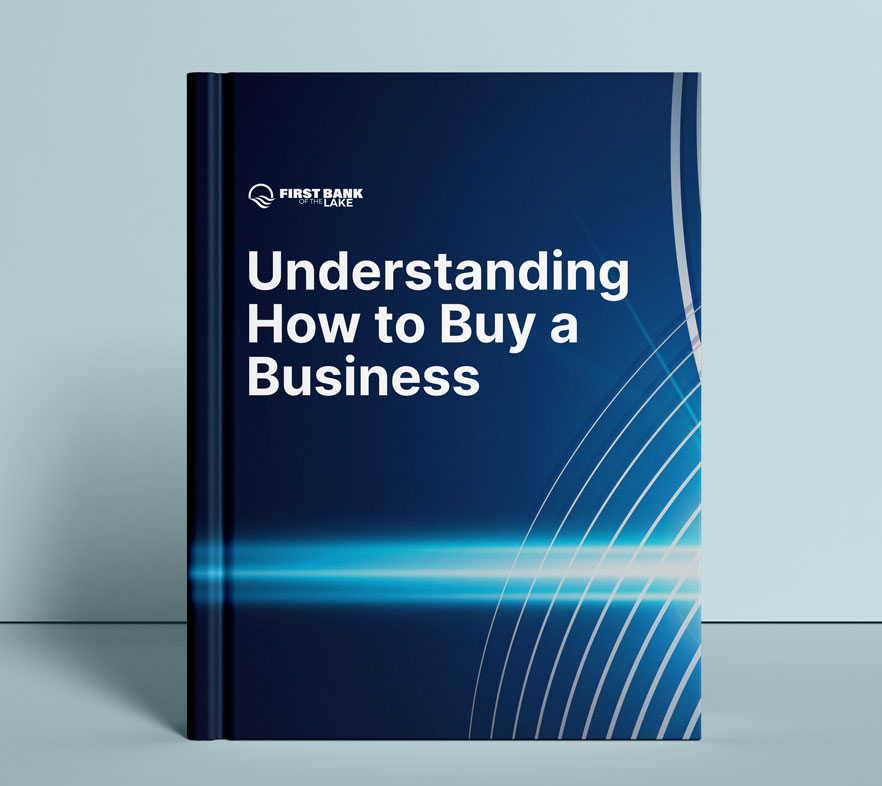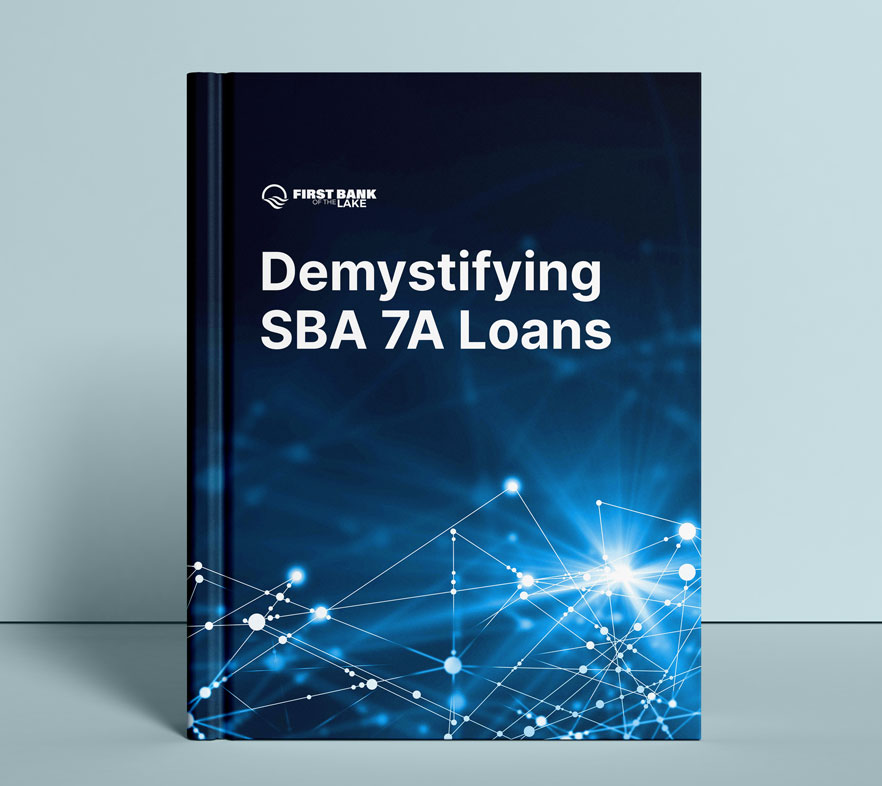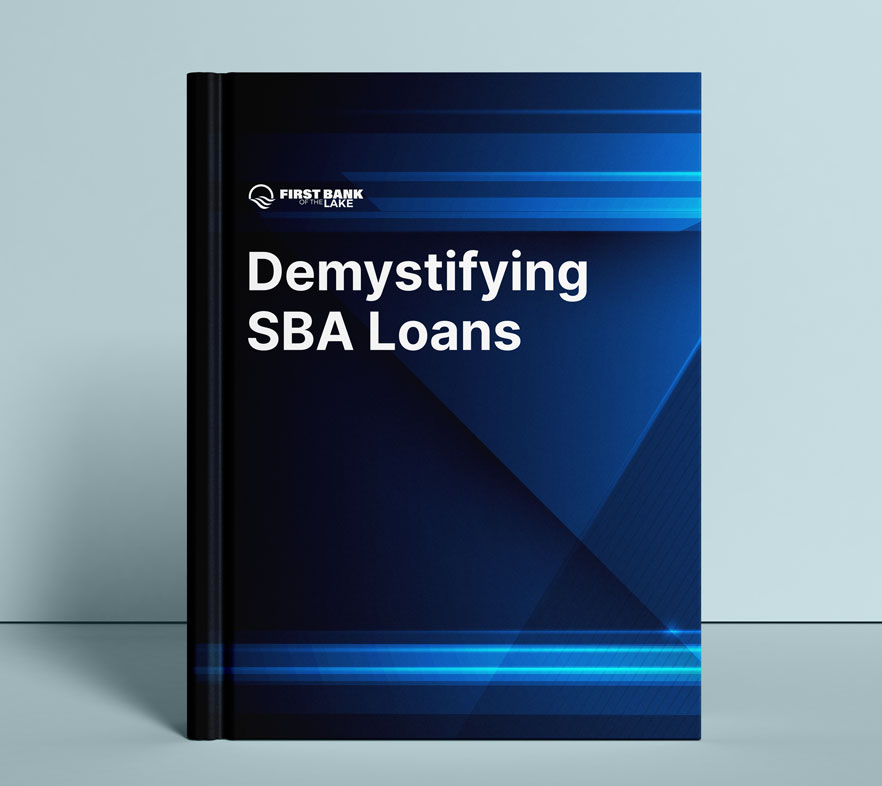SBA Loan Calculator
Home » Calculators »
Use our free small business loan calculator to estimate your SBA loan payment and interest
If you’re a small business owner considering financing options to fuel growth, an SBA loan may have been a vehicle you have considered. Before committing, it’s crucial to understand what those payments will look like and how they’ll fit into your budget. That’s where an SBA loan calculator becomes an invaluable tool. We will walk you through what a small business loan calculator is, how to use it and why it’s a powerful resource for your financial planning.
Your Results
Customer Service: Contact a First Lake Of the Bank representative at (888) 828-0167
Top 5 SBA franchise loan lender*
+$600 million franchise loans funded
+$2 billion in SBA loans since 2020
+2,000 SBA loans funded since 2020
See if You Pre-Qualify for an SBA Loan in 3 Minutes
Get the capital you need to fund your business

Fill in your info:

SBA Loan Calculators
What Is a SBA Loan Calculator?
An SBA loan calculator is a digital tool designed to help small business owners estimate the interest costs and potential loan payments associated with an SBA (Small Business Administration) loan. By inputting key details like loan amount, interest rate, and repayment term, users can quickly calculate their estimated monthly payments, total interest and overall loan cost. This tool simplifies financial planning, allowing business owners to assess affordability and make informed decisions before applying for a loan. While it doesn’t replace professional advice, a working small business loan calculator can provide a clear starting point for understanding how a loan fits into a business budget and long-term financial strategy.
Why Use a Small Business Loan Calculator?
An SBA loan calculator is an essential tool for small business owners planning to secure financing. It helps estimate monthly payments, total interest and overall loan costs, providing a clear picture of affordability. By using this calculator, you can budget confidently, compare different loan scenarios and avoid overcommitting financially. It also prepares you for lender discussions, equipping you with data to negotiate terms that fit your financial budget. Additionally, the calculator saves time by offering instant results, allowing you to focus on strategic financial planning. While not a substitute for advice from accountants or lawyers, it’s a valuable resource for making informed, data-driven borrowing decisions.
How Does the SBA Loan Calculator Work?
An SBA loan calculator works by taking key inputs—loan amount, interest rate, and repayment term, to estimate your monthly payments, total interest and overall loan cost. Simply enter the amount you plan to borrow, the expected interest rate, and the repayment period. Once the data is entered, the calculator uses formulas to generate results instantly, often providing an amortization schedule to show how payments are distributed over time. This tool simplifies complex calculations, helping you understand loan affordability and make better financial decisions easier.

SBA Loan Calculator Information
Please select the SBA 7(a) or 504 calculator tab on the tool.
How to Enter Data for the SBA Loan Calculator for 7a Loans
SBA Loan Calculator: Loan Amount for 7(a) Loans
The loan amounts up to $5 million, based on business needs, financial qualifications, and repayment ability. It can fund working capital, equipment, or business acquisitions.
SBA Loan Calculator: Interest Rate for 7(a) Loans
The interest rate is the annual cost of borrowing, influenced by loan amount, term, and market rates like the Prime Rate. It affects repayment costs and cash flow.
SBA Loan Calculator: Loan Term for SBA 7(a) Loans
The term is the repayment period, up to 10 years for working capital or equipment and 25 years for real estate. Actual terms depend on loan purpose and lender conditions.
How to Use the SBA Loan Calculator Results for 7a Loans
SBA Loan Calculator: 7(a) Loan Monthly Payment
This is the estimated monthly amount, including principal, interest, and fees to help plan cash flow and affordability. Actual payments depend on final loan terms.
SBA Loan Calculator: 7(a) Loan Interest Paid
This estimates the borrowing cost over the loan term, helping borrowers assess affordability and plan finances. Actual rates depend on the prime rate and loan terms.
SBA Loan Calculator: Limitations and Disclaimers
Loan calculators are offered as tools to estimate loan costs based on user inputs like loan amount, interest rate, and term, but these results are not guaranteed and should only be considered a guideline or estimate. Borrowers should use them as a guide and consult financial advisors for tailored advice. At First Bank of the Lake, the information and interactive calculators we provided are intended solely as self-help tools for your independent use. All examples are hypothetical and meant for illustrative purposes only. To ensure clarity and informed decision-making, we encourage users to understand that calculator results are non-binding, based on general assumptions, and subject to change. We strongly recommend consulting directly with one of our loan officers or qualified professionals for personalized guidance tailored to your financial needs.
504 Calculator Information
How to Enter Data for the SBA Loan Calculator for 504 Loans
Please select the SBA 504 calculator tab.
Part 1: Enter Project Details
- SBA Calculator: Loan Purpose – Choose from Purchase, Construction, or Refinance.
- SBA Calculator: Special Use Property – Indicate if the building is special use (Yes) or not (No). Special-purpose property refers to a type of property that is designed for a specific use and cannot easily be converted to another use
- SBA Calculator: Startup Status – Select if your business is a startup (less than 2 years) or established (more than 2 years).
- SBA Calculator: Building/Land Purchase – Use the slider to enter the purchase amount (up to $10M). 504 loans are for real estate or heavy fixed-equipment, not working capital.
- SBA Calculator: Improvements – Enter the property improvement amount (up to $10M combined with Building/Land Purchase).
Part 2: Funding Breakdown
- SBA Calculator – Bank Loan % – Based on your project details, this is the portion funded by a bank.
- SBA Calculator – CDC/SBA Loan % – Determined by your project details, this is the portion funded by the SBA and Community Development Center.
- SBA Calculator: Borrower Contribution % – The borrower’s share, completing the 100% funding total.
Part 3: Loan Terms
- SBA Calculator: Bank Term – The bank loan term is set to 25 years.
- SBA Calculator: Bank Interest Rate – Ranges from 6% to 20%, depending on creditworthiness.
- SBA Calculator: CDC Term – The CDC loan term is fixed at 25 years.
- SBA Calculator: CDC Interest Rate – Set at 6.73%, adjusted monthly based on the Wall Street Journal rate. Actual rates may vary.
How to Use the SBA Loan Calculator Results for 504 Loans
Once you’ve entered data in Parts 1-3, review the results to understand your loan breakdown and costs.
Funding Breakdown
- SBA Calculator: Donut Graph – Displays project costs, bank loan, CDC loan, and borrower contribution. The monthly view excludes the borrower contribution since it’s paid at closing.
- SBA Calculator: Bank Loan – Calculated by multiplying the Bank % (from Part 2) by the Total Project Cost. Interest rates range from 6.73% to 20%, based on creditworthiness.
- SBA Calculator: CDC Loan – Calculated by multiplying the CDC % (from Part 2) by the Total Project Cost. The interest rate updates monthly based on the Wall Street Journal rate.
- SBA Calculator: Borrower Contribution – Determined by multiplying the Borrower % (from Part 2) by the Total Project Cost.
Loan Summary
- SBA Calculators: Total Project Cost – Combines Building/Land Purchase and Improvements from Part 1. Adjust sliders to update costs in real time.
- SBA Calculators: Blended Rate – Averages the Bank and CDC interest rates from Part 3.
- SBA Calculators: Monthly Payment -Divides the Total Project Cost by the Bank and CDC loan terms.
Monthly vs. Total Amounts
Switch between monthly and total views in the upper-right corner. The total excludes the borrower contribution. For more details, click “Get Your Questions Answered.”
SBA 504 Loan Calculator: Limitations and Disclaimers
Loan calculators are offered as tools to estimate loan costs based on user inputs like loan amount, interest rate, and term, but these results are not guaranteed and should only be considered a guideline or estimate. Borrowers should use them as a guide and consult financial advisors for tailored advice. At First Bank of the Lake, the information and interactive calculators we provided are intended solely as self-help tools for your independent use. All examples are hypothetical and meant for illustrative purposes only. To ensure clarity and informed decision-making, we encourage users to understand that calculator results are non-binding, based on general assumptions, and subject to change. We strongly recommend consulting directly with one of our loan officers or qualified professionals for personalized guidance tailored to your financial needs.

Calculating SBA Loan Payments and Interest
Calculate SBA Loan Payment
To use the SBA business loan calculator tool, to calculate an SBA loan payment, you’ll need the loan amount, interest rate, and loan term. Start by determining the monthly interest rate by dividing the annual rate by 12. Then, use this small business loan calculator to estimate your monthly payment, which includes both principal and interest. For example, SBA 7(a) loans typically have terms of up to 10 years for working capital with interest rates tied to the Prime Rate. Calculating payments helps you plan cash flow, assess affordability, and ensure you can meet repayment obligations.
Calculate SBA Loan Interest
Calculating SBA loan interest with the SBA business loan calculator, generally involves understanding the loan amount, interest rate, and term. The tool above can be used as both a SBA loan rates calculator and payment calculator. Start by determining the annual interest rate, often tied to the Prime Rate plus a lender’s margin. Multiply the loan amount by the annual interest rate to find the yearly interest cost. To calculate monthly interest, divide the annual interest by 12. For example, if you borrow $100,000 at a 6% annual rate, the yearly interest is $6,000, or $500 per month. Keep in mind, SBA loans like the 7(a) or 504 may have variable rates, so interest costs can fluctuate over time. Use the calculator for estimates.
SBA Loans
What Is an SBA Loan?
An SBA loan is a financing option provided by lenders but partially guaranteed by the U.S. Small Business Administration (SBA). Designed to support small businesses, these loans offer favorable terms, such as lower interest rates and longer repayment periods, making them more accessible than traditional loans. SBA loans can be used for various purposes, including purchasing equipment, expanding operations, or managing working capital. Popular programs include the 7(a) Loan Program, 504 Loan Program, and Microloans, each tailored to specific business needs. While the application process can be detailed, SBA loans are a valuable resource for businesses seeking affordable growth opportunities.
SBA loans have been instrumental in supporting small businesses across the United States, providing critical funding and driving economic growth. In 2023, the average SBA loan amount was $479,685, with approximately 59% of loan applications being approved. Of these, 34% received full approval, while 25% were partially approved. In terms of total lending, large banks issued $102.7 billion in loans to businesses with revenues under $1 million in 2021. Overall, lending to small businesses through loans of $1 million or less reached an impressive $354.5 billion.
SBA loans are primarily used for essential business needs. A significant portion of loans is allocated to working capital, equipment purchases and business expansion, which account for 33%, 19%, and 15% of loan purposes, respectively.
Between 2021 and 2022, small businesses contributed a net increase of 4.9 million jobs, representing 70% of total job growth, highlighting their vital role in the economy.
Types of SBA Loans
The SBA offers several loan types to meet diverse business needs. The 7(a) Loan Program is the most popular, providing flexible funding for working capital, equipment, or real estate. SBA 504 Loans focus on long-term, fixed-rate financing for major assets like buildings or machinery. Microloans cater to startups and small businesses, offering up to $50,000 for inventory, supplies, or equipment. The SBA Disaster Loan Program helps businesses recover from natural disasters. Additionally, Export Loans support businesses expanding into international markets. Each loan type has specific eligibility requirements and purposes, making SBA loans a versatile option for small business growth.
SBA 7(a) Loan
The 7(a) Loan Program is the Small Business Administration’s most popular and flexible financing option, designed to support a wide range of business needs. It’s an excellent choice for small businesses seeking funding for working capital, equipment purchases, real estate acquisition, or even debt refinancing. With loan amounts of up to $5 million, the program caters to both startups and established businesses looking to grow or stabilize operations.
One of the key advantages of 7(a) loans is their versatility. Borrowers can use the funds for almost any legitimate business purpose, making it a go-to option for entrepreneurs with diverse needs. Repayment terms are tailored to the loan’s purpose, with up to 10 years for working capital and 25 years for real estate, ensuring manageable monthly payments. 7(a) loans can be used for almost any legal purpose and are frequently used for working capital.
Interest rates for 7a loans are competitive, often tied to the prime rate plus a small percentage. These loans are partially guaranteed by the SBA, reducing the risk for lenders and making it easier for businesses to qualify, even with limited collateral or credit history. Using the small business loans calculator provided here, you can estimate the interest and payment for an SBA loan.
The application process involves working with an SBA-approved lender, who will assess your business plan, financials, and creditworthiness. While the process can be detailed, the benefits of a 7(a) loan make it a valuable resource for small business growth. Please also note that you can see many of our 7a loan client case studies that share real loan numbers from actual clients.
SBA 504 Loan
The SBA 504 Loan Program is a specialized financing option offered by the Small Business Administration (SBA) to help small businesses make significant investments in fixed assets. This program is ideal for businesses looking to purchase commercial real estate, heavy machinery, or other long-term assets that drive growth and job creation.
A unique feature of 504 loans is their structure. These loans are typically a partnership between three parties: a Certified Development Company (CDC), a private lender and the borrower. The SBA guarantees up to 40% of the loan through the CDC, the private lender covers a minimum of 50%, and the borrower contributes a minimum of 10% as a down payment. This structure reduces risk for lenders and makes it easier for businesses to secure funding.
The guaranteed loan amounts provided by a certified development company can go up to $5.5 million, with repayment terms ranging from 10 to 25 years, depending on the asset being financed. However, the total loan project can be up to $15 million with the CDC providing up to 40%, the Lender providing a minimum of 50% and the borrower injecting a minimum of 10% of the total project request. The program also offers fixed interest rates, providing predictability for long-term financial planning. The 504 loan is particularly beneficial for businesses focused on expansion, as it supports projects that create jobs and stimulate local economies. While the application process can be detailed, the program’s favorable terms and focus on growth make it a valuable resource for small businesses.

SBA Loan Requirements
How Do I Qualify for an SBA Loan?
Applying for an SBA loan typically involves several steps, but with preparation, the process can be straightforward. Here’s a guide to help you with the SBA loan application:
- Determine Eligibility – Ensure your business meets the SBA’s requirements. You must operate as a for-profit business in the U.S., meet the SBA’s size standards, and demonstrate a need for funding. Additionally, you should have reasonable equity invested in your business and explore other financing options before applying. Using the small business loans calculator provided here, you can estimate the 504 loan interest and payment for an SBA loan.
- Prepare Your Documentation – Gather essential documents, including a detailed business plan, financial statements, tax returns, and a loan application form. Lenders will also require personal financial statements, credit reports, and collateral details.
- Find an SBA-Approved Lender – Work with a lender authorized by the SBA, such as banks, credit unions, or online lenders. The SBA’s Lender Match tool can help you connect with suitable lenders.
- Submit Your Application – Complete the lender’s application process, which includes providing all required documentation. Be prepared to explain how the loan will be used and how your business will repay it.
- Await Approval – The lender will review your application and submit it to the SBA for final approval. Once approved, you’ll receive the funds and can begin using them for your business needs.
Pros and Cons of SBA Loans
Pros of SBA Loans
- Lower Interest Rates: SBA loans typically offer lower interest rates compared to traditional loans, making them more affordable for small businesses.
- Flexible Terms: With repayment terms of up to 25 years for real estate and 10 years for working capital, SBA loans provide manageable monthly payments.
- Accessible for Small Businesses: The SBA’s partial guarantee reduces risk for lenders, making it easier for small businesses to qualify, even with limited credit history or collateral.
- Variety of Loan Programs: From 7(a) loans to 504 loans and microloans, the SBA offers options tailored to different business needs.
Cons of SBA Loans
- Lengthy Application Process: The application process can be time-consuming, requiring extensive documentation and multiple steps.
- Strict Eligibility Requirements: Businesses must meet specific criteria, including size standards and financial health, to qualify.
- Collateral Requirements: Many SBA loans require collateral, which can be a barrier for some businesses.
- Personal Guarantee: Borrowers often need to provide a personal guarantee, putting personal assets at risk.
- Slow Approval Time: Due to the detailed review process, it can take weeks or months to receive funding.
SBA loans are a valuable resource but require careful consideration of their benefits and challenges.
SBA Loan Process, Loan Usage and Business Plan
What Can SBA Loans Be Used For?
SBA loans are versatile and can be used for a variety of business purposes. Common uses include purchasing equipment, inventory, or real estate, as well as funding renovations or expansions. They’re also ideal for working capital to manage day-to-day operations or cover payroll. SBA loans can help refinance existing debt under better terms, reducing financial strain. Additionally, they support specialized needs like exporting, disaster recovery, or acquiring another business. With different loan programs available, such as 7(a) and 504 loans, SBA loans provide small businesses with the flexibility to address both immediate and long-term financial goals.
What Can SBA Loans Not Be Used For?
SBA loans come with restrictions on how the funds can be used. They cannot be used for personal expenses, such as buying a home or paying off personal debts. Additionally, SBA loans cannot finance illegal activities, speculative investments, or gambling-related ventures. Businesses cannot use the funds to reimburse owners for previously incurred expenses or to refinance debt that would place the lender at undue risk. Loans also cannot be used to relocate a business in a way that causes job loss. These restrictions ensure SBA loans are used responsibly to support legitimate business growth and economic development.
Is a Business Plan Needed for an SBA 7(a) Loan?
A business plan is typically required when applying for an SBA 7(a) loan. Lenders use the business plan to assess your business’s viability, financial health, and repayment ability. A well-prepared business plan demonstrates your understanding of the market, your strategy for success, and how the loan will be used to achieve your goals.
What’s Included in an SBA Loan Business Plan?
- Executive Summary: A concise overview of your business, including its mission, vision, and key objectives.
- Business Description: Details about your business, such as its structure, industry, and unique value proposition.
- Market Analysis: Research on your target market, customer demographics, and competitors, showing you understand the industry landscape.
- Organization and Management: Information about your team, including roles, responsibilities, and qualifications.
- Products or Services: A description of what you offer, highlighting how it meets customer needs.
- Marketing and Sales Strategy: Your plan for attracting and retaining customers, including pricing, promotions, and distribution.
- Financial Projections: Detailed forecasts of revenue, expenses, and cash flow, along with past financial statements.
- Loan Purpose: A clear explanation of how the loan will be used and how it will benefit your business. A strong business plan increases your chances of securing an SBA 7(a) loan.
Maximum SBA Loan Limits, Loan Terms & Approval
The maximum borrowing amounts for SBA loans vary by program. For the 7(a) Loan Program, the maximum loan amount is $5 million. This program is versatile, covering a wide range of business needs like working capital, equipment, and real estate.
For the SBA 504 Loan Program, the maximum guaranteed loan amount is also $5.5 million, but with the total project loan amount may be up to $15 million, with the Certified Development Company (CDC) financing up to 40%, the lender providing a minimum of 50% and the remaining amount provided by the borrower. The SBA 504 loan program is specifically designed for purchasing fixed assets such as commercial real estate or heavy machinery. The 504 loan structure makes it ideal for large-scale investments and expansion projects.
What is the Typical Duration or Term of a Small Business Loan?
The duration or term of a small business loan depends on the loan type and its purpose. For SBA 7(a) loans, terms typically range from 7 to 25 years, depending on how the funds are used. Working capital loans usually have shorter terms of up to 10 years, while loans for real estate can extend up to 25 years.
For SBA 504 loans, terms are generally 10, 20, or 25 years, tailored to the asset being financed. Non-SBA loans may have shorter terms, often between 1 to 5 years. Longer terms usually mean lower monthly payments but higher overall interest costs.
How Long Does it Typically Take for a 7(a) Loan to Be Approved or Made?
The approval process for an SBA 7(a) loan typically takes 30 to 90 days, depending on the lender and the complexity of the application. The timeline includes gathering required documentation, lender review, and SBA approval. Some lenders offer SBA Express loans, which provide a faster decision within 36 hours, but these loans are capped at $500,000. The actual disbursement of funds may take additional time after approval, depending on the lender’s processes. To expedite the process, ensure all required documents, such as financial statements and business plans, are complete and accurate before submitting your application.
Helpful Links
- SBA 7a Loan Calculator
- SBA 504 Loan Calculator
- SBA 7a vs 504 Loans
- Business Loan Calculator
- SBA Loan Resources, Guides, ePubs and tools
- Buy a Business with an SBA Loan
- SBA 7a Loans by State

What Our Customers Say
Gave Me the Confidence I Needed
Huge thanks to Tammy and Brandi. Tammy was my first point of contact and gave me the confidence I needed since there isn't a local branch near where I live. Brandi has been answering ALL my questions since and has excellent follow up and has taken great care of me.
— Michele Houston
Genuinely Interested in Helping My Business Succeed
First Bank of the Lake was a tremendous help in securing a 504 small business loan for my company. Every staff member I interacted with was professional, friendly, and genuinely interested in helping my business succeed.
— Don Kamb
Exceptional Service
I cannot say enough positive things about my experience working with Eric as my SBA loan officer. From start to finish, he provided exceptional service and went above and beyond to ensure that every issue we encountered was resolved quickly and efficiently.
— Bryan Crowe
Real business owners. Real results.
Woof Gang Bakery SBA Loan Case Study
After years in HR, Kasia followed her passion for animals and, with a $345K SBA loan from First Bank of the Lake, quickly launched her Woof Gang Bakery & Grooming franchise — already nearing breakeven just months in.
Tint World SBA Loan Case Study
After losing his wife, a friend, and his life savings, Dan Billings reinvented his life with a Tint World franchise — and with guidance and an SBA loan from First Bank of the Lake, his business is thriving and he’s already eyeing a second location.
Lifetime Green Coatings SBA Loan Case Study
Father and son duo Barry and Parker Norfleet launched six Lifetime Green Coatings franchises with a $400K SBA loan from First Bank of the Lake — quickly setting up operations and nearly breaking even within just three months.
Download Free ePubs on Buying a Business and SBA Loans

Learn how we’ve made hundreds of franchise loans

Learn how to buy your own business from the experts

Learn how to get an SBA 7A loan and grow your business



